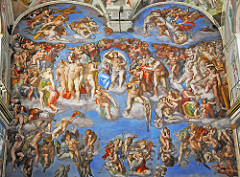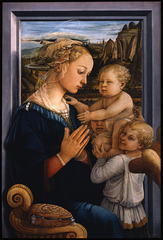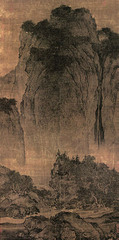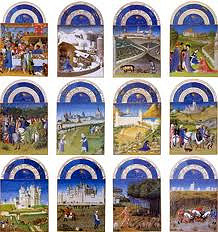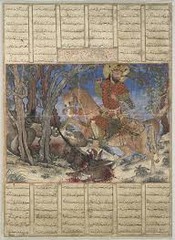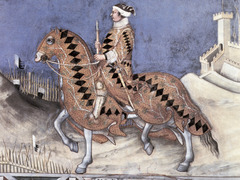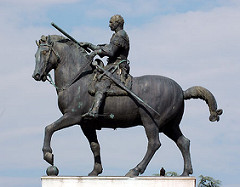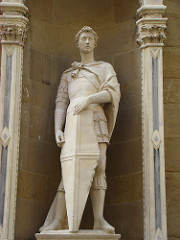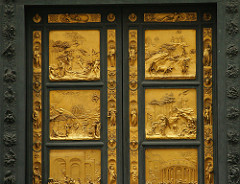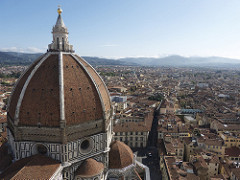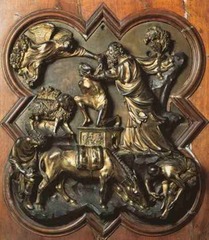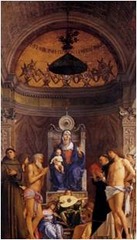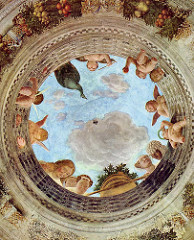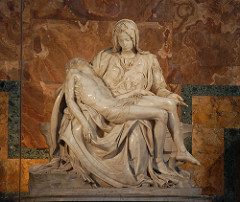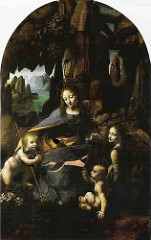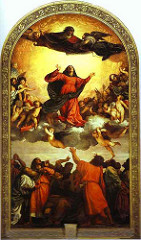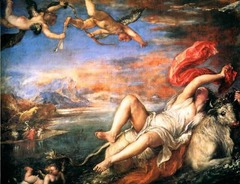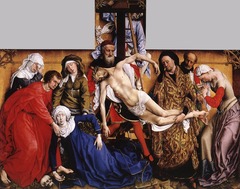
– A SMALL CHAPEL CONNECTED TO A PALACE (FAMILY OF BANKERS)
-NEXT TO A HOLY ROMAN ARENA
GIOTTO’S USE OF LIGHT AND SHADOW
-MARY’S GRIEF SHOWS HER HUMANITY (HUMANISM)
-ORGANIZED IN 3 DIFFERENT ROWS
1. TELLS THE STORY OF MARY
2. SHOWS CHRIST’S LIFE
3. PASSION (CHRIST’S DEATH AND IMMEDIATELY AFTER)
SCENE OF LAST JUDGEMENT AND THE ARREST OF CHRIST/KISS OF JUDAS SHOWS GIOTTO’S FOCUS ON DRAMA IN ART—- THE INTENSITY OF THE COLORS (HIGHLY SATURATED) AND THE FACIAL EXPRESSIONS

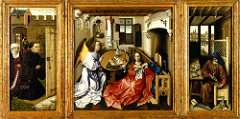
-three panels
Left: Donors peering into the house
Middle: House scene
Right: Joseph crafting a mousetrap (symbol for the trap of the devil) to keep the devil from entering the home)
view of a typical flemish city in the background
lots of religious symbolism in a modern mercantile environment
portable, made for upper middle class home (shows the new material culture and how art was more affordable on the public sector)
homely feel, the piece takes place in the house
christ with golden reigns and cross on back flies toward Mary (angel Mary in the center)
multiple view points, no linear perspective (very different from Masaccio and Brunelleschi)
very disproportionate, figures too big for the space, floor and table tilted

-Brunelleschi wanted to return to the classical tradition of Ancient Rome by creating a centrally planned space with barrel vaulting, pendentives, and a hemispherical dome with an oculus to let light in. He also focused on the geometric elements of Ancient Roman art as many rectangular and circular structures are included. He uses Pietra serena,a grayish green tone to emphasize the decorative narratives on the walls. This return to classicism is influential in High Renaissance art, but was very unusual for the time period.The Pazzi chapel was a chapter house, so local monks met there.

humanist elements in his architecture
influenced by the colosseum, integrated different capitals, first floor=tuscan, second is ionic and third has corinthian
expression of loyalty to Medici palace located nearby
use of pilasters and rounded arches
delicate light masonry compared to the medici
more rational and intellectual—-geometry and lightness, sense of cerebral
used to welcome guests, for business and for family residence
reflects the civic pride of time period, everyone wanted to beautify the city
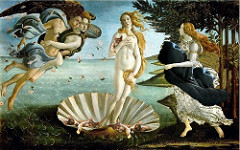
Idea:
If we can contemplate physical beauty (elegance of Venus’s pose, the waves flowers and the birds) than we can understand divine beauty (Venus)
breaking convention (only acceptable nude was Eve)
sensual
flexibile, skelatel
zephyrs on left
we can see the wind behind the zephyrs to show Venus’s interaction with the natural elements
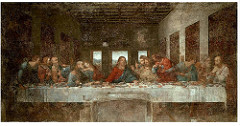
scene of Christ with his 12 apostles, each seated in 3 groups of 4 showing Da Vinci’s attention to math and symmetry
the moment is the reaction to Christ announcing that one of them will betray him
the facial expressions and hand gestures are very obvious, showing the use of humanism and realism in the Renaissance
unable to enter the space. The piece is actually placed 10-15 ft above our eye, creating a divide between us and the divine world
BREAD AND WINE
Judas holding the silver, reaching for BOWL at the same time to symbolize the betrayal
very simplified, no decor and windows are plain and symmetrical (Davinci was more intellectual and strait forward)

-engraving of Adam and Eve with nude bodies in frontal form (GRECO_ROMAN) but heads are in profile gazing at each other
very dramatic use of the space (he was prolific) no empty spaces
the animal symbolism the elk ox bird and rabbit represent the 4 humors of human personality
eve reaching for the apple to represent sin
his work is very humanist, captures all different aspects of human life facial proportions are ideal rather than real, the distance from her forehead to chin is less proportional, more beautiful

covers 4 walls: each wall represents a different idea such as philosophy, theology, blend of human ideas with religious ideas which is very new of the time period
plato and Aristotle holding their respective books in the center, surrounding by similar philosophers. Euclid near Aristotle as they are both mathematical, but Pythagorus and Plato who are more focused on the ideal
greek gods in background and roman architecture such as barrel vaults and pilasters: showing respect of the knowledge of greek and romans
pays homage to Michelangelo by depicting him seated with the philosophers
moses holding the 10 commandments
the bread===link between heaven and earth
members of religious orders, Dante the poet
PLATO POINTS TO HEAVEN AS HE IS INTERESTED IN THE IDEAL AND PERFECTION WHILE ARTISTOLE’S BOOK POINTS DOWNWARD BECAUSE HE IS INTERESTED IN EARTHLY THINGS SUCH AS MATH AND SCIENCE
the figures are coming to divine knowledge through these philosophers

elongated figures
highly stylized
less naturalistic
curved lines for each figure===very fluid, creates movement in all different directions
vanishing point unclear, no place for eye to rest
Mary and supporters look distraught, expressive
art
short reaction to high renaissance
influenced by the end of Florentine republic
The figures DO NOT exist as real people in a realistic space created with the use of linear perspective.
Pontormo is not interested in stability or balance, which were important artistic elements in the Renaissance.
The figures are highly stylized and there is a strong rejection of the rational spaces of Renaissance paintings.
Some of the figures are positioned in unnatural poses and they are set in a complex group without a clear focal point—unlike the structured pyramidal groups of the High Renaissance.
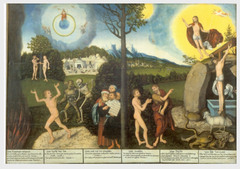
On the “gospel” side of the image (the right side), John the Baptist directs a naked man to both Christ above and below the tomb. The risen Christ stands triumphant above the empty tomb, acting the miracle of the Resurrection. Doesnt want to follow the law or be accepted on judgement day He stands passively, stripped down to his soul, submitting to God’s mercy.
On the left side is the law side, young christ is concerned with the law. In the left foreground a skeleton and a demon force a frightened naked man into hell, as a group of prophets, including Moses, point to the tablets of the law. The motifs on the left side of the composition are meant to exemplify the idea that law alone, without gospel, can never get you to heaven. Christ sits in Judgment as Adam and Eve (in the background) eat the fruit and fall from grace. Moses beholds these events from his vantage point toward the center of the picture, his white tablets standing out against the saturated orange robe and the deep green tree behind him, literally highlighting the association of law, death, and damnation.
Taken together, these motifs demonstrate that law leads inescapably to hell when mistaken for a path to salvation, as the damned naked man demonstrates.
Heaven is reached through faith and god’s grace
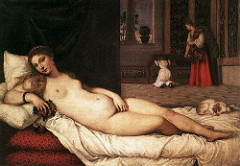
With this painting, Titian established the genre of the reclining female nude that many later artists would use.
Titian manipulated the proportions of the body to make the figure especially elegant.
The painting is of a female nude and was given the title after it was painted, which justified the nude female figure.
use of tempura glaze
The overt sensuality —- softness of the colors
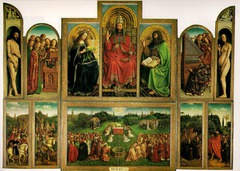
-polyptych
can be viewed open or closed
-top is the prophets and sybils who predicted the coming of christ
middle–the coming of Christ (THE ENUNCIATION) Gabriel announcing to Mary he is going to announce christ
Gabriel holds lilies (symbol of purity) mary with dove above her head, speaking to Gabriel
(words upside down)
very concrete and physical, but the words are more imaginative and speak to god
linear perspective
unrealistic human body (the drapery hides the body)
enormous alterpiece
2 figures and 2 sculptures
sculptures=saints figures=normal people
The artists are not using linear perspective or representing the human body naturalistically..
There is tension between the writing, which is a medieval convention, and the Renaissance realism of the scene.
The Annunciation, foretold by the prophets and sibyls, takes place in the central panels. The Angel Gabriel visits Mary to tell her she will have a baby.
In the center of the center panel, GOD is dressed like a king with the papal crown on his head and another crown at his feet.
The fabric of God’s throne shows the image of the pelican, who is feeding its children on its own flesh and blood. This is an image of God’s love and forgiveness.
The angels playing instruments and others who are singing recall the sounds of heaven.
In representing a forgiving God, the van Eyck brothers are showing the influence of Humanism.

The setting for this scene of the Annunciation is spare, with few additional details or objects, which is appropriate to this space.
In this scene, the Angel Gabriel appears to Mary to tell her that she will bear a child that is God.
This painting is missing some of the iconographic and narrative details that normally accompany the scene, allowing the monks to fill in the details for themselves.
Fra Angelico shows an awareness of the latest stylistic trends in , but also shows an unwillingness to employ them fully.
Both Mary and the angel are idealized, but lack the facial details to make them look like real individuals.

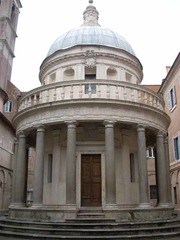
-pagan architecture and Christian theme, which was common in the Renaissance
-no inscriptions
-peristyle columns
-hemispherical dome
matryrium to commemorate St. Peter
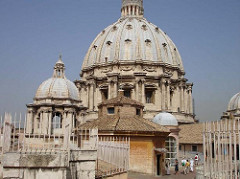
-double dome like Brunelleschi’s Florence Chapel
-massive pilasters that go through 2 stories of the building
-alternating windows
charecteristics of his paintings also seen in his architecture such as chiarescuro and sfumato

-commisioned by St. Peter
-intended to be a funerary monument
-Mary mourning Christ’s death
-Mary’s heavy drapery hides her size
looks very young
-not much emphasis on her facial features
-very serene
-elongated body of Christ
-Christ depicted nude, nudity is considered the highest form of idealization
-unpainted as Michaelangelo preferred to maintain the purity of white marble
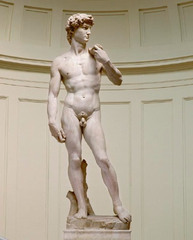
-contraposto pose
-looks alert, anticipating challenge (with Goliath)
-meant to show the heroic, powerful empire Florence was to France
-very idealized and proportional
-first colossal nude since ancient world
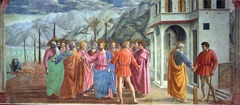
-depicts the scene where St. Peter asks Christ if he should pay the tax collectors, but Christ tells him to hook a fish from sea and take coin from the mouth. Christ then confronts the brutish looking tax collector, while Peter goes to get the money
-scene from the New testament
-narrative from left to right
-atmospheric perspective background
-figures cast shadows
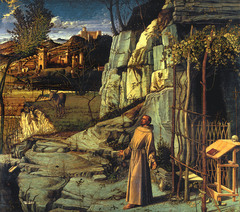
No stage props of divinity
Artists are interested in interpreting the stories of the bible form fully naturalistic ways
Getting this hidden symbolism from the Renaissance
Grapevine refers to the eucharist, the wine, blood of Christ
Plants are identifiable by species
Interrelation between the spiritual and real world
May be the most extensive treatment of landscape to this day
Bellini has enlarged the background, drawing off but not like other Renaissance painting
Expression of humanism in Renaissance
Our natural world can ennoble us
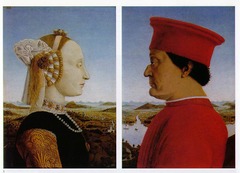
known for humanism, use of geometric form, perspective
interested in N. Renaissance art, often borrows ideas, landscape, sense of imagination, composition (geometry of painting)/ organization
commissioned by Duke Federico da Montefeltro (1467-72)
painting features Duke’s late wife, Duchess Battista Sforza shortly after her death in order to commemorate her
High forehead, plucked, is borrowed from the Northern artists and ideals, as well as the detailed landscape
looking at landscape from above, towering over, powerful and authoritative
Profile based off coin of ancient Rome
Usually profiles are done facing the right, like the wife is, Duke is facing left (towards his wife, looking at her) either to show affection and personal connection or because the Duke had suffered injury on the other side of his face which caused him to lose an eye and part of his nose
Diptych joined by a hinge. When closed painting of two chariots becomes visible. The chariot on the left with the white horses has the Duke and a personification of Justice (holding scales) and on the right chariot with the brown unicorns is the Duchess and her virtues- used imagination to create sense of nobility and iconography
Sense of harmony, symmetry, geometry, idea of perspective, classic portraits all = classic Renaissance

Unlike many works of medieval art, the Allegory and Effects of Good and Bad Government is a and not work of art.
The Allegory and Effects of Bad Government shows the figure of Tyranny surrounded by vices. Poor government leads to in the city and country.
Allegories in art are figures that stand in for ideas
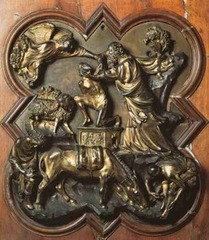
Brunelleschi’s panel shows a violent and dramatic moment where Abraham is in the process of killing Isaac before he is stopped by the angel.
Problem
Compared with Brunelleschi’s panel, Ghiberti’s panel is more emotionally complex as Abraham hesitates as looks directly into Isaac’s face.
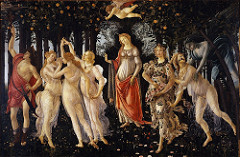
Tittle: Primavera
Date:1482
Medium: Painting
Significance: The painting, depicting a group of mythological figures in a garden, is allegorical for the lush growth of Spring, other meanings have also been explored.

Shows the inert body of Christ surrounded by the Virgin, St. Peter and Mary Magdalene, St. John the Evangelist, St. Jerome and St. Paul
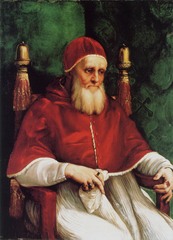
shows anxiety over the Protestant Reformation, holding St. Peter’s keys

Takeaway: Circular tondo is symbol for divine perfection
New testament biblical theme common for the renaissance with vibrant colors .
Mary is dressed in contemporary renaissance clothing.
Baby Jesus holds a scepter of a cross as foretelling of his crucifixion.
Geometric development of the composition as a right triangle.
James the brother of jesus is shown looking at the christ, NOT mary.
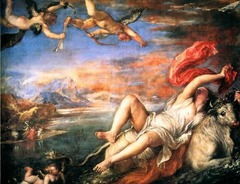
Titian 1559-1562
commissioned by Phillip II of Spain (twelve years after this painting arrived in Spain, Titian was still waiting to be paid by the King)
subject matter: classical mythology, has to do with another love of Jupiter
Europa is walking along the shore when Jupiter appears guised as a white bull and takes her
Europa is posed in a very suggestive/erotic way
Composition: diagonals are used everywhere to create dynamic movement, has a very broad range of colors
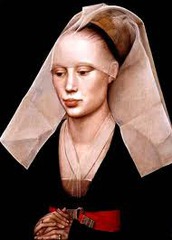
Date: 1460
Artist/Architect: Rogier Van Der Weyden
Period/Style: Northern Renaissance
Original Location: Flanders
Material/Technique:oil on panel
Function: commissioned portrait of an unknown young woman whose dress and bearing imply noble rank.
Context/relevant ideas relating to artwork: contrasts with formal Italian approach which conveyed little of the sitter’s personality. Unlike van Eyck, Rogier place little emphasis on surface detail, and instead, defined large simple places to achieve an almost abstract effect.
Descriptive terms: lowered eyes, tightly locked thin fingers, fragile physique, reserved, pious demeanor,flat, sharply pointed angular shapes
Meaning of the work/message of work: created the portrait to not only present a faithful likeness of her somewhat plain features but also her individual character.
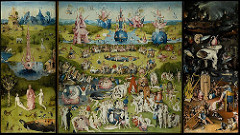
Date: 1505-1510
Artist/Architect:Hieronymus Bosch
Period/Style:15th Century Flemish Art
Original Location: Palace of Henry III of Nassau in Netherlands
Material/Technique: Oil on wood
Function: It is a painting on a triptych. The extreme subject matter of the inner center and right panels make it unlikely that it was intended to function in a church or monastery, but was instead commissioned by a lay patron.
Context/relevant ideas relating to artwork: In the left panel, God presents Eve to Adam in a landscape, possibly Garden on Eden. The right panel bombards viewers with the horrors of Hell. The huge central panel depicts nude people in a landscape of bizarre creatures, unidentifiable objects, and fertility symbols.
Descriptive terms:enigmatic, 7ft, 12 feet wide, secular commission, marriage, sex, procreation, wedding commemoration,
Meaning of the work/message of work: serves as a warning to viewers of the fate awaiting the sinful, decadent, and immoral.

1443, Bourges, France
.rich entrepreneurial merchant who amassed a fortune
.many gothic details in window frames (tracery, arches)
.house surrounds open interior courtyard; irregular plan

This portrait shows the artist fully frontal, which was a pose that was generally reserved for Christ
Dürer studied art in Italy and brought his knowledge back to his home country of Germany
equating his skills with Christ as Christ gave him his talents
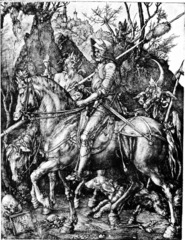
Albrecht Durer Woodprint, 1500
Life is running out of time
Knight: Christianity
Death: Holding an hourglass
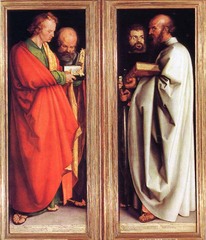
-Oil on wood panel
-Martin Luther’s translation of bible under foot
-Different temperments are shown in expression and shade
-Angularities of drapery
-Protestant reformation halted the completion of the middle panel

This picture, painted around 1594, belongs to the second Fontainebleau school. It shows Gabrielle d’Estrées, who was Henri IV’s mistress, together with her sister, the Duchess of Villars, in the bath. But is it really her sister? Probably, since the two women look alike. But what about that gesture? The pinching of the nipple could signify that Gabrielle is pregnant, a supposition corroborated by the maidservant in the background sewing a layette—but is it really a layette? And what of the ring…? Gabrielle, who was waiting for the King to repudiate his official wife, Marguerite de Valois, had three children by him and died before the age of thirty, while pregnant with her fourth child, in 1599. So? Never mind: apart from its mysterious subject, this work displays a somewhat mediocre technique.
Portrait of Henry VIII
1539-40
Sesnse of Enormous presence
It’s a frontal view! Jewels sown into the costume and on his hat. It’s an iconic image like a medieval saint
Figure of great power!
Holbein capable of putting forth propaganda details
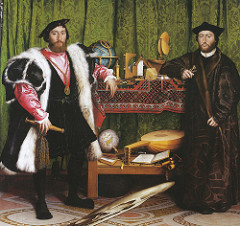
The French Ambassadors
1533
THIS SHOWCASED HIS TALENT. HE BECAME THE COURT PAINTER AFTER THIS POINT.
-Anamorphic: SKULL
-REPRESENTS CHURCH & STATE
a lot of care into putting painting together.
Holbein figures that he wants this painting to showcase his talents and it helps him get noticed by Henri the 8th
Led him to gaining the position
8ft high. Double portrait
Left: French ambassador, and on the right: bishop who was visiting him
Ages: 25 and 29
An image of Church & State.
Dominant position: State.
Specific instruments to show the angle of the sun/ times of day/ times of year. Measuring time. High tech equipment. Being introduced for astronomy navigation and time
Bottom shelf: globe of world: geography
Arithmetic & Geometry for handling numbers. Astronomy and Music. Notes were related: musical scales deal with numbers.
Liberal Arts Made up 7 different studies. Associated with the idea that if you were a free person in society, then this is how you should be educated
Lower shelf: globe shows Europe, Spain, and France. Musical Lutheran Book.
Broken string on guitar: indication of discord. Although there’s a sense of unity between the two men, things are still not great for Europe at this time.
An anamorphic image: object that’s been stretched out, can be seen if you’re on the edge, or can be reflected on a mirror: it’s a scull – symbol of death. It’s a disguised image.
Positive interpretation: you can raise to be educated into the heavenly realm.
Negative/More accurate interpretation: dance of death: omnipresence of death. INVEVITABLE. Ultimately coming for everyone. Cynical view/ fashionable/ sophisticated court. Somber message concealed in painting. Trend that was going on: mannerism.
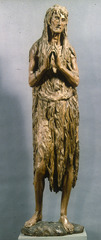
Donatello.
Mary Magdalene -In wood, covered completely in her hair
-Revel I her ugliness
-Wood adds brittleness, roughness
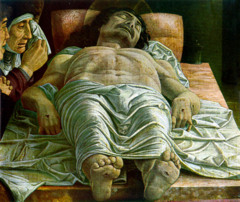
-Most radical experiment in foreshortening yet
-What is more important: Display of artist’s virtuoso skill or subject of worship or Christ?
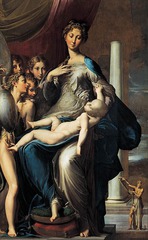
Parmigianino, Madonna with the Long Neck, 1534-40, oil on wood panel, 7’1″ x 4’4″. Galleria degli Uffizi, Florence
-left unfinished at early death
-assumed to sit on throne but no seat
-languid expanse of sleeping child (Pieta, again)
-diagonal band across Virgin’s chest
-well-known image in a challenging manner
-temple was supposed to be in background
-boys block view
-giant b/c proportions are so off
-completely imaginary figures
-tiny hand perched on top (talk about being a diamond shape)
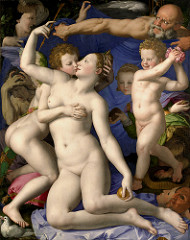
-Bronzino
-oil on wood Bronzino (Agnolo di Cosimo)
-Cosimo I, Duke of Tuscany
-allegory of unchaste love and deceit
-enamel-like smoothness
-contoured figures impossibly posed
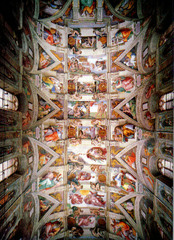
The outer scenes show the prophets and sibyls that foretell the coming of Christ.
The scenes from the central panel show the Temptation of Adam and Eve and their Expulsion from Eden indicating the need for Christ’s sacrifice in the New Testament.
The scenes along the central panel represent episodes from Genesis in the Old Testament.
-brought a sculptural element to his paintings
Michelangelo’s figures recall the strength, beauty, and idealism of classical sculpture.
The sibyls were ancient pagan soothsayers who could foresee the future and in the Catholic tradition, they foretold the coming of Christ.
Michelangelo used a male model for the Libyan sybil, which may explain the great physical strength we see in her body.
